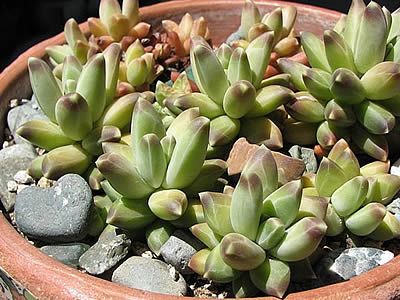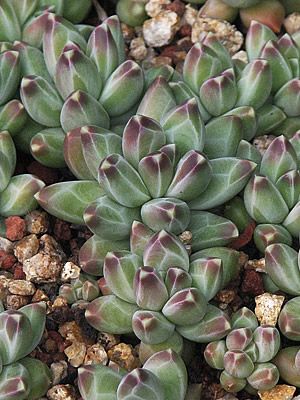The Little Jewel (Pachyphytum compactum) is a succulent species, native to Mexico, that captures the attention of collectors with its multifaceted leaves, as if they had been cut like a precious stone. It is stoloniferous, and its leaves grow in dense rosettes, ranging in shape from round to cylindrical, with pointed apices and white veining that merge to create an interesting faceted appearance.

The colors and shapes range from light green to grayish, with reddish tips, but they can change depending on the cultivar and environmental conditions. They tend to be greener and more elongated in partial shade and more colorful and compact in full sun, cold, and dry conditions. It occasionally blooms, with bell-shaped flowers in yellow, orange, or pink emerging above the foliage. Varieties include P. compactum cristatus, which forms dense rounded masses, and P. compactum ‘Rosé,’ with pinkish rosettes.

A unique plant, with a hard stone-like appearance but extremely delicate. Care must be taken when handling the species during replanting and division, as its leaves detach very easily. Nevertheless, each detached leaf is an excellent propagation method that should be utilized.
It exhibits slow to moderate growth, but it is well worth having this little gem in your succulent collection. Its unique texture and colors make it an excellent complement to other species or as a dense carpet in pots and containers, adorned with stones that enhance its foliage.

The little jewel should be grown in full sun or partial shade, in well-draining cactus and succulent soil that is lightweight, sandy, and enriched with organic matter. Watering should be sparse, allowing the substrate to dry between waterings.
Watering is more frequent in spring and summer, and significantly reduced in autumn and winter. Like many succulents, the little jewel does not tolerate waterlogged conditions, which can lead to rapid root rot, so avoid using it in terrariums without drainage or with trays under the pots. It does not withstand prolonged intense cold well.
Its colors, shapes, and contrasts are more vibrant when exposed to sunlight, drought, and cold. It propagates easily through leaf cuttings and by separating the new rosettes that form around the mother plant. Allow the leaves and new rosettes to dry for 24 hours in the shade before planting.


